Pre-Operative Combination of Normal BMI with Elevated YKL-40 and Leptin but Lower Adiponectin Level Is Linked to a Higher Risk of Breast Cancer Relapse: A Report of Four-Year Follow-Up Study
Abstract
1. Introduction
2. Material and Methods
2.1. Compliance with Ethical Standards
2.2. Description of the Patients’ Cohort
2.3. Inclusion and Exclusion Criteria
2.4. Collection of Clinical Data
2.5. Follow-Up Details
2.6. Blood Sampling and Laboratory Tests
2.7. Serum Leptin Measurement
2.8. Serum Adiponectin Analysis
2.9. Serum YKL-40 Assay
2.10. Citrate Plasma TF Activity
2.11. Immunohistochemical Detection of Hormone Receptors, Ki67, and HER2
2.12. Statistical Methods
3. Results
3.1. Clinical Summarisation of the Study Population
3.2. Analysed Parameters According to Age, Menopausal Status, Parity Status, and Body Mass Index among BrC Cases
3.3. Distribution of YKL-40, Leptin, and Adiponectin Concentrations and TF Activity According to Immunohistochemical Determinants in the Study Cohort
3.4. Distribution of YKL-40, TF Activity, Leptin, and Adiponectin According to Clinicopathological Characteristics in the Study Group
3.5. Predictive Factors for Invasive BrC in Multivariate Cox Proportional Hazards Regression Analysis
3.6. Assessment of the Analysed Parameters’ Ability to Predict Disease Recurrence; Analysis by the Receiver Operating Characteristics Curve (ROC)
3.7. Survival Predictive Value of Pre-Treatment YKL-40 Concentration (A), TF Activity (B), and BMI (C)
3.8. Survival Time Analysis with Respect to the Combination of YKL-40 Concentration with TF Activity (3A), the BMI Value with TF Activity (3B), the BMI Value with YKL-40 Level (3C), the BMI Value with Leptin Level (4A), and the BMI Value with Adiponectin Level (4B)
3.9. Survival Time Analysis with Respect to Parity Status
4. Discussion
4.1. Baseline Values of YKL-40, Leptin, Adiponectin, and TF Activity with Respect to Demographic, Anthropometric, and Clinicopathological Features
4.2. YKL-40 Level and TF Activity as Predictors of Disease Recurrence
4.3. BMI’s Value as a Predictor of Disease Recurrence
4.4. Combination of BMI Values with YKL-40 Level and BMI with Leptin and Adiponectin as Predictors of Disease Recurrence
5. Conclusions
Author Contributions
Funding
Acknowledgments
Conflicts of Interest
References
- Demark-Wahnefried, W.; Campbell, K.L.; Hayes, S.C. Weight management and its role in breast cancer rehabilitation. Cancer 2012, 118 (Suppl. S8), 2277–2287. [Google Scholar] [CrossRef] [PubMed]
- Gelsomino, L.; Naimo, G.D.; Catalano, S.; Mauro, L.; Andò, S. The emerging role of adiponectin in female malignancies. Int. J. Mol. Sci. 2019, 20, 2127. [Google Scholar] [CrossRef] [PubMed]
- Picon-Ruiz, M.; Morata-Tarifa, C.; Valle-Goffin, J.J.; Friedman, E.R.; Slingerland, J.M. Obesity and adverse breast cancer risk and outcome: Mechanistic insights and strategies for intervention. CA Cancer J. Clin. 2017, 67, 378–397. [Google Scholar] [CrossRef] [PubMed]
- Ray, A. Cancer and comorbidity: The role of leptin in breast cancer and associated pathologies. World J. Clin. Cases 2018, 6, 483–492. [Google Scholar] [CrossRef] [PubMed]
- Widschwendter, P.; Friedl, T.W.; Schwentner, L.; DeGregorio, N.; Jaeger, B.; Schramm, A.; Bekes, I.; Deniz, M.; Lato, K.; Weissenbacher, T.; et al. The influence of obesity on survival in early, high-risk breast cancer: Results from the randomized SUCCESS A trial. Breast Cancer Res. 2015, 17, 129. [Google Scholar] [CrossRef] [PubMed]
- Pajares, B.; Pollán, M.; Martín, M.; Mackey, J.R.; Lluch, A.; Gavila, J.; Vogel, C.; Ruiz-Borrego, M.; Calvo, L.; Pienkowski, T.; et al. Obesity and survival in operable breast cancer patients treated with adjuvant anthracyclines and taxanes according to pathological subtypes: A pooled analysis. Breast Cancer Res. 2013, 15, R105. [Google Scholar] [CrossRef]
- Rubio-Jurado, B.; Balderas-Peña, L.M.; García-Luna, E.E.; Zavala-Cerna, M.G.; Riebeling-Navarro, C.; Reyes, P.A.; Nava-Zavala, A.H. Obesity, thrombotic risk, and inflammation in cancer. Adv. Clin. Chem. 2018, 85, 71–89. [Google Scholar]
- Chen, L.; Kong, X.; Wang, Z.; Wang, X.; Fang, Y.; Wang, J. Pre-treatment systemic immune-inflammation index is a useful prognostic indicator in patients with breast cancer undergoing neoadjuvant chemotherapy. J. Cell Mol. Med. 2020, 24, 2993–3021. [Google Scholar] [CrossRef]
- Breast Cancer: Statistics. Available online: https://www.cancer.net/cancer-types/breast-cancer/statistics (accessed on 6 April 2020).
- Pham, D.V.; Raut, P.K.; Pandit, M.; Chang, J.H.; Katila, N.; Choi, D.Y.; Jeong, J.H.; Park, P.H. Globular adiponectin inhibits breast cancer cell growth through modulation of inflammasome activation: Critical role of Sestrin2 and AMPK signaling. Cancers (Basel) 2020, 12, 613. [Google Scholar] [CrossRef]
- Sánchez-Jiménez, F.; Pérez-Pérez, A.; de la Cruz-Merino, L.; Sánchez-Margalet, V. Obesity and breast cancer: Role of leptin. Front. Oncol. 2019, 9, 596. [Google Scholar] [CrossRef]
- Gong, T.T.; Wu, Q.J.; Wang, Y.L.; Ma, X.X. Circulating adiponectin, leptin and adiponectin-leptin ratio and endometrial cancer risk: Evidence from a meta-analysis of epidemiologic studies. Int. J. Cancer 2015, 137, 1967–1978. [Google Scholar] [CrossRef] [PubMed]
- Graf, C.; Ruf, W. Tissue factor as a mediator of coagulation and signaling in cancer and chronic inflammation. Thromb. Res. 2018, 164, 143–147. [Google Scholar] [CrossRef] [PubMed]
- Kjaergaard, A.D.; Nordestgaard, B.G.; Johansen, J.S.; Bojesen, S.E. Observational and genetic plasma YKL-40 and cancer in 96,099 individuals from the general population. Int. J. Cancer 2015, 137, 2696–2704. [Google Scholar] [CrossRef]
- Yeo, I.J.; Lee, C.K.; Han, S.B.; Yun, J.; Hong, J.T. Roles of chi tinase 3-like 1 in the development of cancer, neurodegenerative diseases, and inflammatory diseases. Pharmacol. Ther. 2019, 26, 107394. [Google Scholar] [CrossRef] [PubMed]
- Roslind, A.; Knoop, A.S.; Jensen, M.B.; Johansen, J.S.; Nielsen, D.L.; Price, P.A.; Balslev, E. YKL-40 protein expression is not a prognostic marker in patients with primary breast cancer. Breast Cancer Res. Treat. 2008, 112, 275–285. [Google Scholar] [CrossRef]
- Wang, D.; Zhai, B.; Hu, F.; Liu, C.; Zhao, J.; Xu, J. High YKL-40 serum concentration is correlated with prognosis of Chinese patients with breast cancer. PLoS ONE 2012, 7, e51127. [Google Scholar] [CrossRef]
- Johansen, J.S.; Christensen, I.J.; Jorgensen, L.N.; Olsen, J.; Rahr, H.B.; Nielsen, K.T.; Laurberg, S.; Brunner, N.; Nielsen, H.J. Serum YKL-40 in risk assessment for colorectal cancer: A prospective study of 4,496 subjects at risk of colorectal cancer. Cancer Epidemiol. Biomark. Prev. 2015, 24, 621–626. [Google Scholar] [CrossRef]
- Bielawski, K.; Rhone, P.; Bielawska, S.; Rość, D.; Brkic, A.; Zarychta, E.; Ruszkowska-Ciastek, B. Heparanase link between vasculogenesis and angiogenesis as well as a predictive factor of a shorter survival rate. J. Physiol. Pharmacol. 2019, 70, 455–466. [Google Scholar]
- Hanahan, D.; Weinberg, R. Hallmarks of cancer: The next generation. Cell 2011, 144, 374–646. [Google Scholar] [CrossRef]
- Christodoulatos, G.S.; Spyrou, N.; Kadillari, J.; Psallida, S.; Dalamaga, M. The role of adipokines in breast cancer: Current evidence and perspectives. Curr. Obes. Rep. 2019, 8, 413–433. [Google Scholar] [CrossRef]
- Arai, Y.; Kamide, K.; Hirose, N. Adipokines and aging: Findings from centenarians and the very old. Front. Endocrinol. (Lausanne) 2019, 10, 142. [Google Scholar] [CrossRef] [PubMed]
- Playdon, M.C.; Bracken, M.B.; Sanft, T.B.; Ligibel, J.A.; Harrigan, M.; Irwin, M.L. Weight gain after breast cancer diagnosis and all-cause mortality: Systematic review and meta-analysis. J. Natl. Cancer Inst. 2015, 107, djv275. [Google Scholar] [CrossRef] [PubMed]
- Jarde, T.; Caldefie-Chezet, F.; Damez, M.; Mishellany, F.; Penault-Llorca, F.; Guillot, J.; Vasson, M.P. Leptin and leptin receptor involvement in cancer development: A study on human primary breast carcinoma. Oncol. Rep. 2008, 19, 905–911. [Google Scholar] [CrossRef] [PubMed]
- Ando, S.; Gelsomino, L.; Panza, S.; Giordano, C.; Bonofiglio, D.; Barone, I.; Catalano, S. Obesity, leptin and breast cancer: Epidemiological evidence and proposed mechanisms. Cancers (Basel) 2019, 11, 62. [Google Scholar] [CrossRef] [PubMed]
- Panno, M.L.; Naimo, G.D.; Spina, E.; Ando, S.; Mauro, L. Different molecular signaling sustaining adiponectin action in breast cancer. Curr. Opin. Pharmacol. 2016, 31, 1–7. [Google Scholar] [CrossRef]
- Maroni, P. Leptin, adiponectin, and sam68 in bone metastasis from breast cancer. Int. J. Mol. Sci. 2020, 21, 1051. [Google Scholar] [CrossRef]
- Che, S.P.; DeLeonardis, C.; Shuler, M.L.; Stokol, T. Tissue factor-expressing tumor cells can bind to immobilized recombinant tissue factor pathway inhibitor under static and shear conditions in vitro. PLoS ONE 2015, 10, e0123717. [Google Scholar] [CrossRef]
- Parise, C.A.; Caggiano, V. Breast cancer survival defined by the ER/PR/HER2 subtypes and a surrogate classification according to tumor grade and immunohistochemical biomarkers. J. Cancer Epidemiol. 2014, 2014, 469251. [Google Scholar] [CrossRef]
- Gu, L.; Cao, C.; Fu, J.; Li, Q.; Li, D.H.; Chen, M.Y. Serum adiponectin in breast cancer: A meta-analysis. Medicine (Baltimore) 2018, 97, e11433. [Google Scholar] [CrossRef]
- Lennon, H.; Sperrin, M.; Badrick, E.; Renehan, A.G. The obesity paradox in cancer: A review. Curr. Oncol. Rep. 2016, 18, 56. [Google Scholar] [CrossRef]
- Murphy, W.J.; Longo, D.L. The surprisingly positive association between obesity and cancer immunotherapy efficacy. JAMA 2019, 321, 1247–1248. [Google Scholar] [CrossRef] [PubMed]
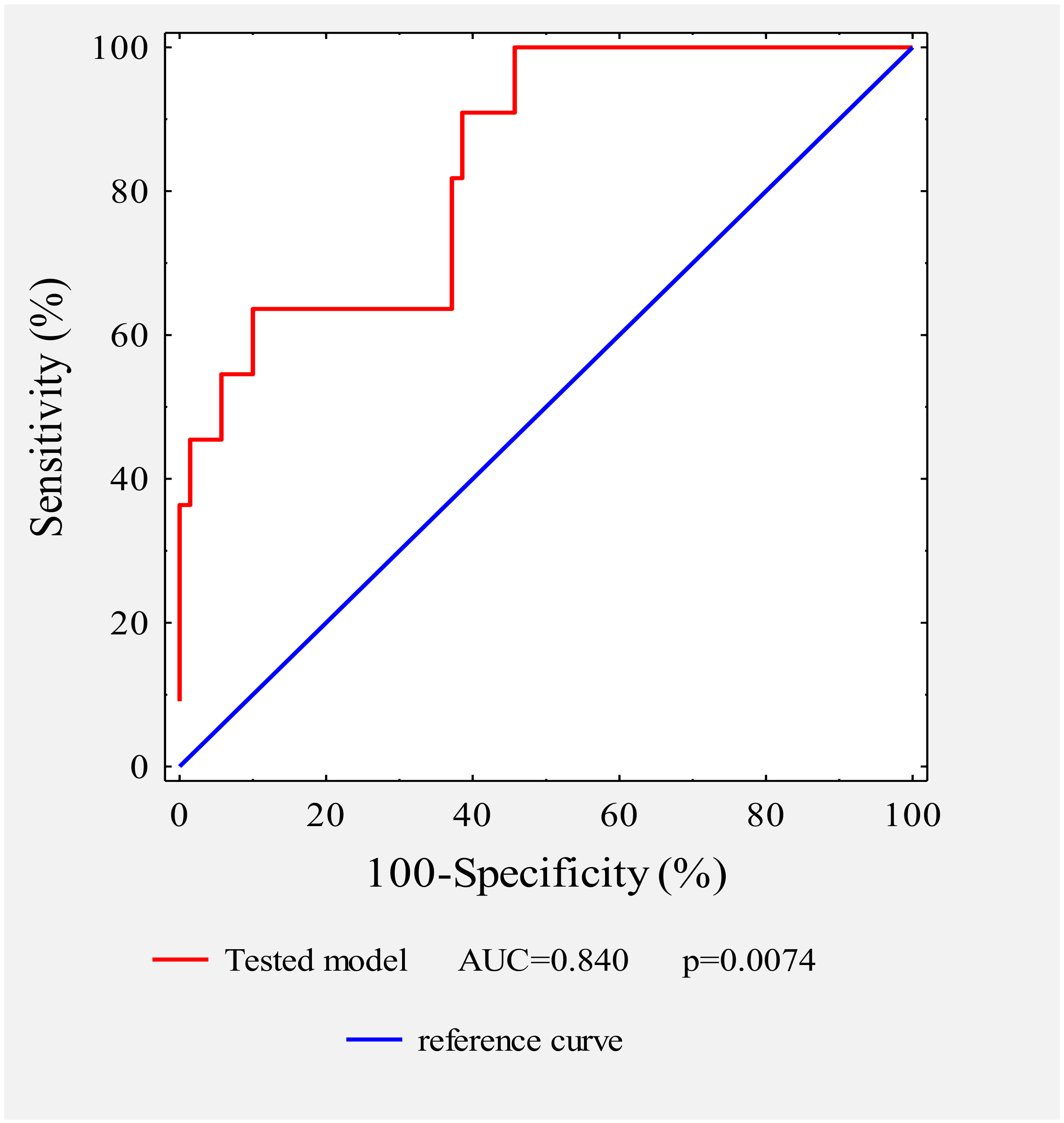
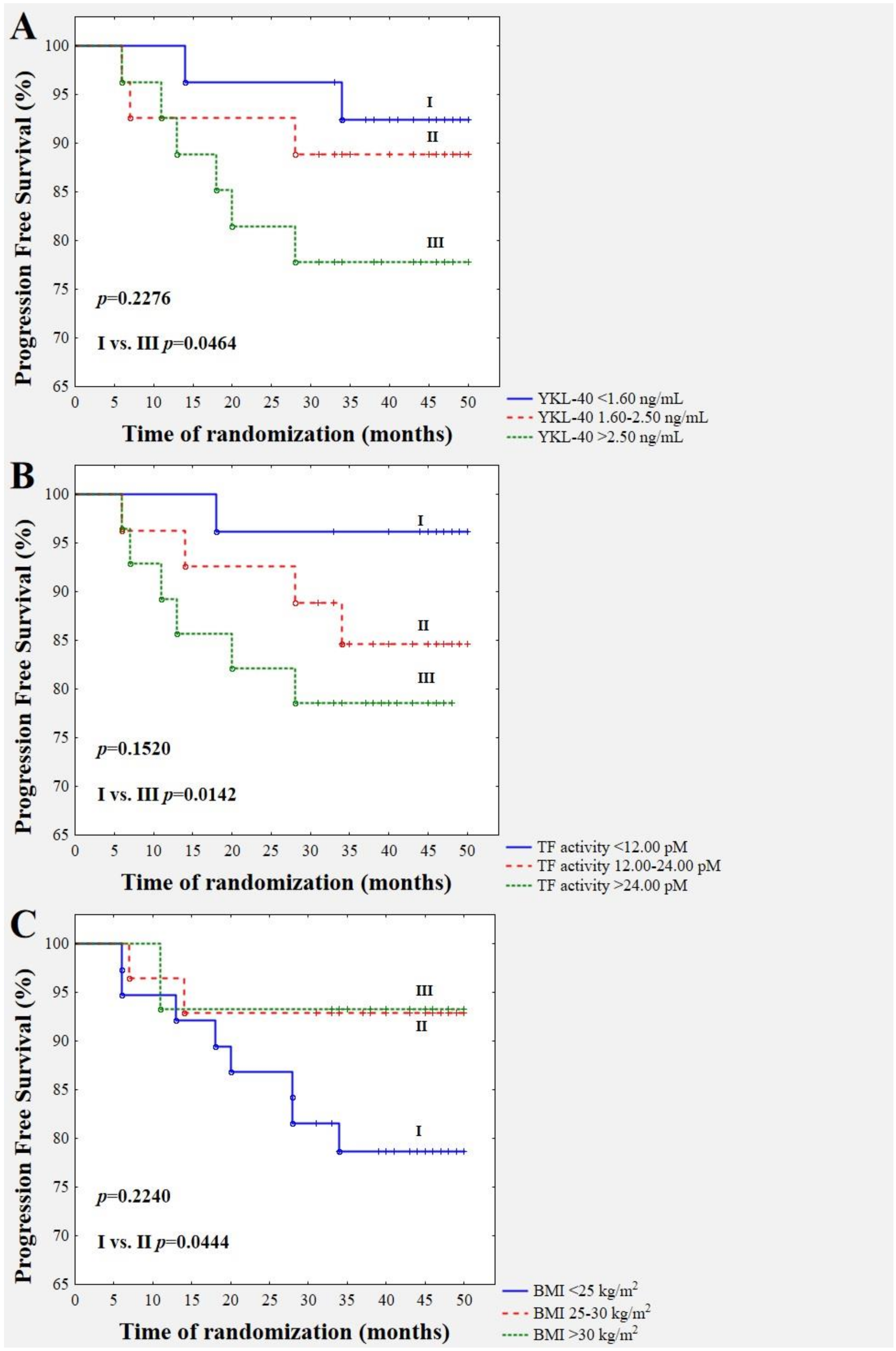
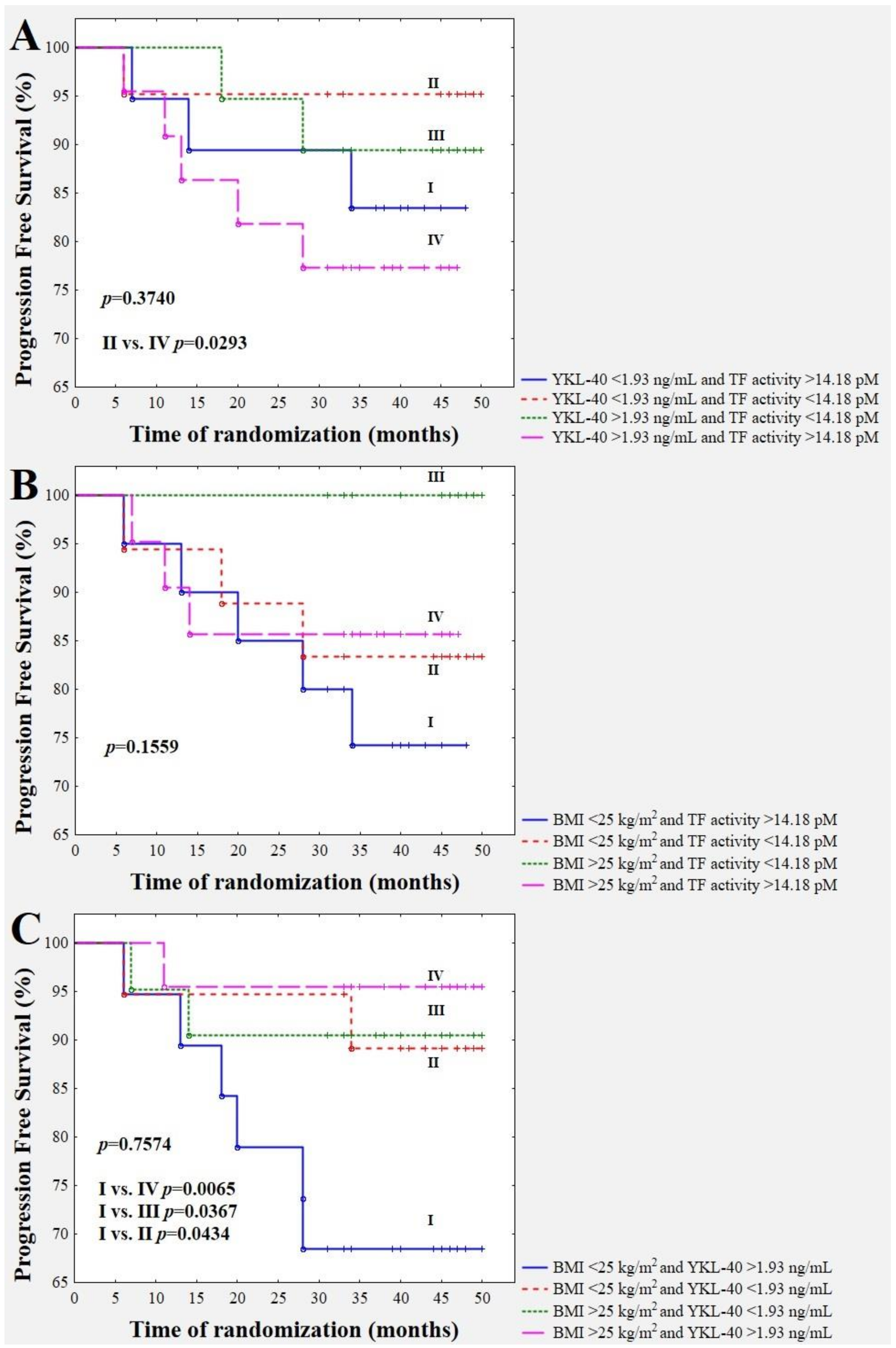
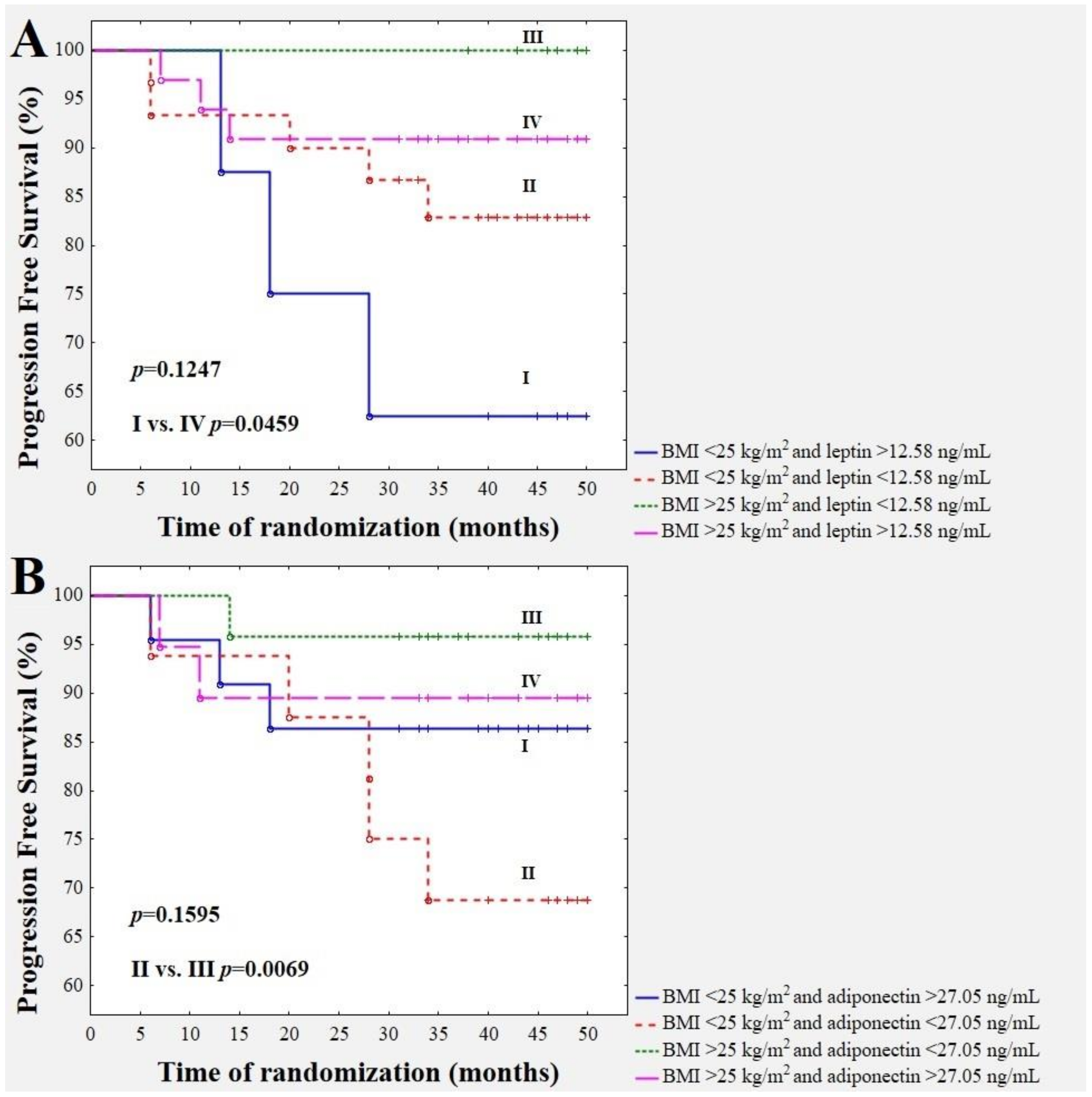
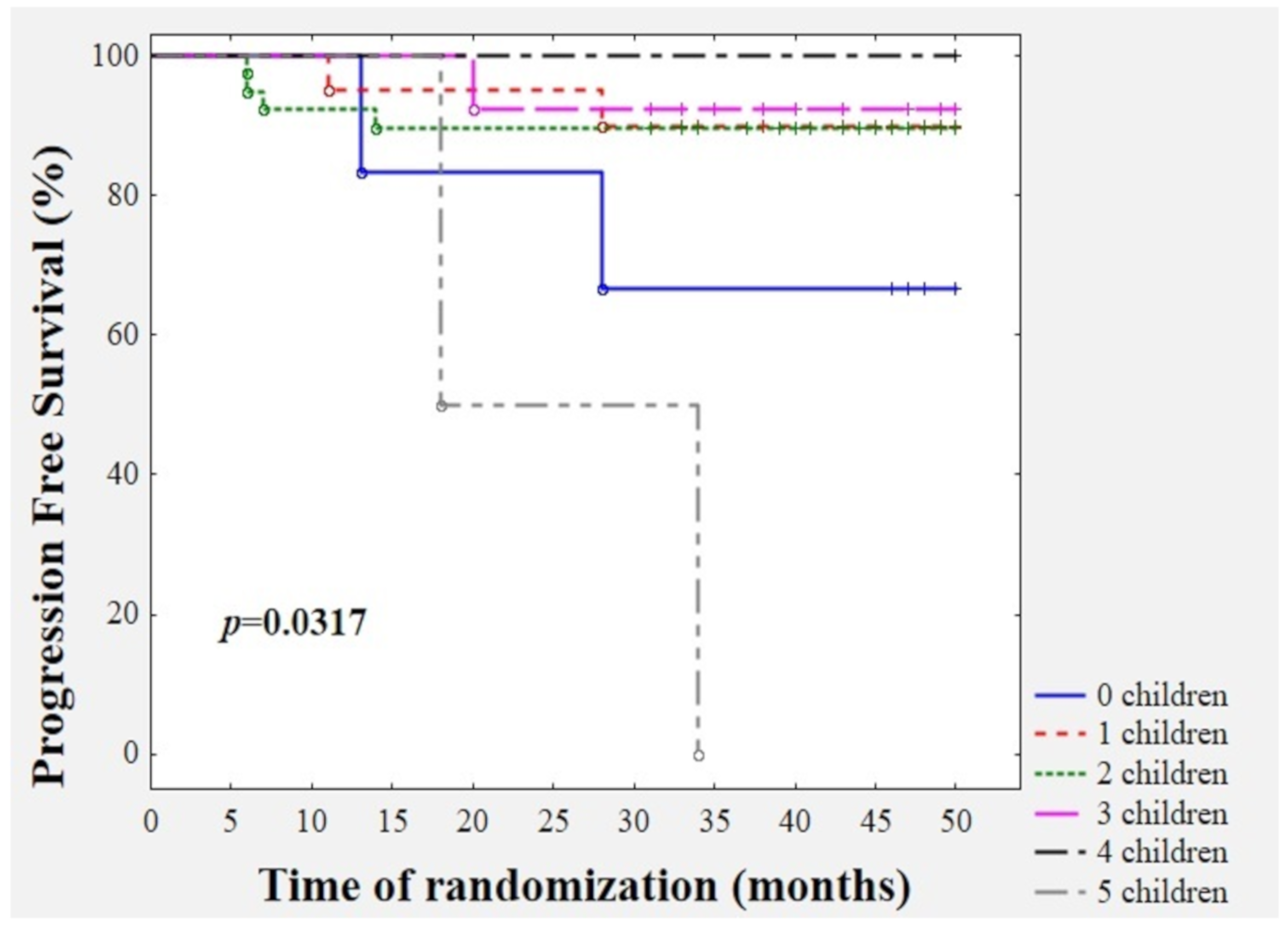
| Variables/Number of Patients (%) | YKL-40 Concentration (ng/mL) | TF Activity (pM) | Leptin Concentration (ng/mL) | hsAdiponectin Concentration (ng/mL) |
|---|---|---|---|---|
| 81 (100%) | 1.93 1.43/2.83 | 14.18 11.59/26.92 | 12.58 4.70/20.64 | 27.05 20.63/32.10 |
| Age | ||||
| <55 years | 1.87 | 15.20 | 8.77 | 25.24 |
| n = 41 (51%) | 1.44/2.81 | 12.31/28.76 | 4.43/18.26 | 19.76/29.09 |
| ≥55 years | 2.01 | 13.64 | 12.65 | 28.07 |
| n = 40 (49%) | 1.42/3.25 | 11.10/26.40 | 5.46/23.58 | 23.25/32.63 |
| Menopausal status | ||||
| Premenopausal | 1.89 | 17.59 | 7.80 | 25.24 |
| n = 27 (33%) | 1.33/2.81 | 12.31/25.20 | 4.00/19.21 | 19.76/30.30 |
| Postmenopausal | 1.96 | 13.79 | 12.67 | 27.42 |
| n = 54 (67%) | 1.45/2.85 | 11.17/29.59 | 5.57/22.47 | 22.62/32.31 |
| Body mass index | *** | I vs. III * | ||
| 18.5–24.9 kg/m2 | 1.91 | 16.29 | 5.30 | 28.19 |
| n = 38 (47%) | 1.36/2.85 | 11.77/29.59 | 3.12/11.56 | 23.88/33.63 |
| 25.0–29.9 kg/m2 | 1.85 | 14.01 | 14.31 | 27.02 |
| n = 28 (35%) | 1.43/2.54 | 11.73/25.38 | 8.70/21.63 | 19.28/32.12 |
| 30.0–39.9 kg/m2 | 2.35 | 15.20 | 25.72 | 24.44 |
| n = 15 (18%) | 1.78/2.90 | 9.02/38.2 | 16.92/40.85 | 16.93/27.91 |
| Number of parity | II vs. III **II vs. IV * | II vs. IV *III vs. IV * | ||
| Nulliparous | 2.24 | 13.21 | 10.29 | 23.55 |
| n = 6 (7%) | 1.42/2.83 | 11.62/21.31 | 5.57/31.39 | 20.51/34.83 |
| 1 child | 2.53 | 17.41 | 13.06 | 27.81 |
| n = 20 (25%) | 2.02/2.93 | 9.53/36.63 | 6.33/23.02 | 24.20/32.97 |
| 2 children | 1.64 | 14.99 | 12.63 | 27.47 |
| n = 39 (48%) | 1.33/2.57 | 12.31/25.88 | 3.73/19.40 | 20.64/33.27 |
| 3 children | 1.78 | 13.70 | 12.38 | 24.44 |
| n = 13 (16%) | 1.35/2.35 | 11.47/33.47 | 3.78/23.60 | 18.29/27.37 |
| 4 children n = 1 (1%) | 1.06 | 11.65 | 9.60 | 12.17 |
| 5 children | 1.96 | 15.82 | 10.46 | 21.54 |
| n= 2 (2%) | 1.36/2.55 | 8.05/23.59 | 4.00/16.92 | 14.58/28.49 |
| Molecular Determinants/Number of Patients (%) | YKL-40 Concentration (ng/mL) | TF Activity (pM) | Leptin Concentration (ng/mL) | hsAdiponectin Concentration (ng/mL) |
|---|---|---|---|---|
| Expression of Ki67 | * | |||
| <20% | 1.86 | 13.79 | 12.36 | 28.19 |
| n = 52 (64%) | 1.31/2.57 | 10.82/25.20 | 4.11/18.69 | 22.94/33.11 |
| ≥20% | 2.42 | 22.18 | 14.41 | 25.24 |
| n = 29 (36%) | 1.62/2.87 | 11.86/38.98 | 6.17/23.88 | 16.74/27.91 |
| Expression of HER2 | ||||
| Negative | 1.91 | 14.99 | 12.61 | 27.12 |
| n = 72 (89%) | 1.42/2.84 | 11.55/29.18 | 4.81/20.71 | 20.64/32.22 |
| Positive | 2.44 | 12.46 | 8.77 | 26.99 |
| n = 9 (11%) | 1.44/2.56 | 11.59/15.20 | 3.67/16.92 | 19.18/27.91 |
| Hormone receptor status | ||||
| ER+ | 2.02 | 14.55 | 12.55 | 27.09 |
| n = 70 (86%) | 1.42/2.87 | 11.47/26.92 | 4.92/20.64 | 20.64/32.31 |
| ER– | 1.64 | 14.18 | 13.83 | 27.05 |
| n = 11 (14%) | 1.58/2.43 | 11.86/31.56 | 3.78/22.47 | 14.70/28.13 |
| PgR+ | 2.00 | 15.10 | 12.61 | 26.91 |
| n = 66 (81%) | 1.42/2.85 | 11.47/26.92 | 5.26/20.78 | 20.64/32.94 |
| PgR– | 1.78 | 13.70 | 7.79 | 27.13 |
| n = 15 (19%) | 1.58/2.83 | 11.77/31.56 | 3.67/18.26 | 16.74/28.13 |
| Feature/Number of Patients (%) | YKL-40 Concentration (ng/mL) | TF Activity (pM) | Leptin Concentration (ng/mL) | hsAdiponectin Concentration (ng/mL) |
|---|---|---|---|---|
| Molecular subtypes | * | I vs. IV * | ||
| Luminal A | 1.91 | 13.92 | 12.61 | 28.88 |
| n = 50 (62%) | 1.33/2.92 | 10.61/25.20 | 5.57/20.64 | 22.62/33.63 |
| Luminal B HER2− | 2.81 | 36.18 | 12.38 | 25.24 |
| n = 13 (16%) | 1.83/2.85 | 19.62/39.18 | 4.00/19.21 | 20.51/27.71 |
| Luminal B HER2+ and Non-Luminal HER2+ n = 9 (11%) | 2.44 1.44/2.56 | 12.46 11.59/15.20 | 8.77 3.67/16.92 | 26.99 19.18/27.91 |
| Basal-like | 1.62 | 14.18 | 13.83 | 24.44 |
| n = 9 (11%) | 1.58/1.78 | 11.86/31.56 | 3.78/22.47 | 14.70/27.47 |
| Tumour diameter | ||||
| T1 (2 cm) | 1.87 | 14.99 | 12.38 | 27.13 |
| n = 55 (68%) | 1.42/2.92 | 11.62/25.88 | 4.43/22.47 | 20.64/32.31 |
| T2 (≥2 cm <5 cm) | 2.14 | 14.03 | 13.57 | 26.22 |
| n = 26 (32%) | 1.50/2.81 | 10.42/29.59 | 4.92/18.26 | 18.79/32.1 |
| Nodal status | ||||
| LN− | 2.16 | 16.29 | 12.30 | 27.02 |
| n = 62 (77%) | 1.52/2.92 | 11.17/25.88 | 4.7/22.47 | 20.51/32.13 |
| LN+ | 1.58 | 13.88 | 13.83 | 27.18 |
| n = 19 (23%) | 1.29/2.48 | 11.77/29.88 | 4.60/18.26 | 23.34/31.14 |
| Stage of disease | ||||
| IA | 2.19 | 18.28 | 12.30 | 27.06 |
| n = 40 (49%) | 1.48/3.04 | 11.53/25.72 | 4.85/26.21 | 20.36/31.95 |
| IIA + IIB | 1.89 | 13.88 | 12.63 | 27.05 |
| n = 41 (51%) | 1.36/2.51 | 11.62/29.59 | 4.70/17.89 | 23.34/32.10 |
| Elston and Ellis grade | ||||
| G1 + G2 | 2.03 | 14.06 | 12.51 | 26.83 |
| n = 65 (80%) | 1.43/2.92 | 11.47/25.88 | 4.92/20.64 | 20.64/32.13 |
| G3 | 1.63 | 15.10 | 14.35 | 27.59 |
| n = 16 (20%) | 1.39/2.43 | 12.31/37.58 | 4.57/20.37 | 17.61/29.70 |
| Histological type | * | * | ** | |
| Ductal | 2.03 | 14.99 | 13.53 | 26.23 |
| n = 69 (85%) | 1.58/2.90 | 11.47/28.76 | 5.34/22.47 | 19.76/30.30 |
| Lobular | 1.38 | 13.64 | 5.00 | 32.70 |
| n = 12 (15%) | 1.17/2.09 | 12.06/24.12 | 2.81/13.18 | 28.83/34.41 |
| Variables | HR | 95% CI | p-Value | |
|---|---|---|---|---|
| BMI | 0.75 | 0.59 | 0.95 | 0.0178 |
| TF activity | 1.07 | 1.01 | 1.14 | 0.0240 |
| YKL-40 | 0.82 | 0.51 | 1.35 | 0.4434 |
| Leptin | 1.21 | 1.02 | 1.44 | 0.0327 |
| hsAdiponectin | 0.86 | 0.76 | 0.97 | 0.0135 |
| Variables/Number of Patients (%) | YKL-40 Concentration (ng/mL) | TF Activity (pM) | Leptin Concentration (ng/mL) | hsAdiponectin Concentration (ng/mL) |
|---|---|---|---|---|
| Progression 18.5–24.9 kg/m2 n = 8 (10%) | 2.69 1.82/3.46 | 24.09 13.85/40.49 | 5.41 3.77/15.67 | 21.59 17.61/29.88 |
© 2020 by the authors. Licensee MDPI, Basel, Switzerland. This article is an open access article distributed under the terms and conditions of the Creative Commons Attribution (CC BY) license (http://creativecommons.org/licenses/by/4.0/).
Share and Cite
Bielawski, K.; Rhone, P.; Bulsa, M.; Ruszkowska-Ciastek, B. Pre-Operative Combination of Normal BMI with Elevated YKL-40 and Leptin but Lower Adiponectin Level Is Linked to a Higher Risk of Breast Cancer Relapse: A Report of Four-Year Follow-Up Study. J. Clin. Med. 2020, 9, 1742. https://doi.org/10.3390/jcm9061742
Bielawski K, Rhone P, Bulsa M, Ruszkowska-Ciastek B. Pre-Operative Combination of Normal BMI with Elevated YKL-40 and Leptin but Lower Adiponectin Level Is Linked to a Higher Risk of Breast Cancer Relapse: A Report of Four-Year Follow-Up Study. Journal of Clinical Medicine. 2020; 9(6):1742. https://doi.org/10.3390/jcm9061742
Chicago/Turabian StyleBielawski, Kornel, Piotr Rhone, Marek Bulsa, and Barbara Ruszkowska-Ciastek. 2020. "Pre-Operative Combination of Normal BMI with Elevated YKL-40 and Leptin but Lower Adiponectin Level Is Linked to a Higher Risk of Breast Cancer Relapse: A Report of Four-Year Follow-Up Study" Journal of Clinical Medicine 9, no. 6: 1742. https://doi.org/10.3390/jcm9061742
APA StyleBielawski, K., Rhone, P., Bulsa, M., & Ruszkowska-Ciastek, B. (2020). Pre-Operative Combination of Normal BMI with Elevated YKL-40 and Leptin but Lower Adiponectin Level Is Linked to a Higher Risk of Breast Cancer Relapse: A Report of Four-Year Follow-Up Study. Journal of Clinical Medicine, 9(6), 1742. https://doi.org/10.3390/jcm9061742






